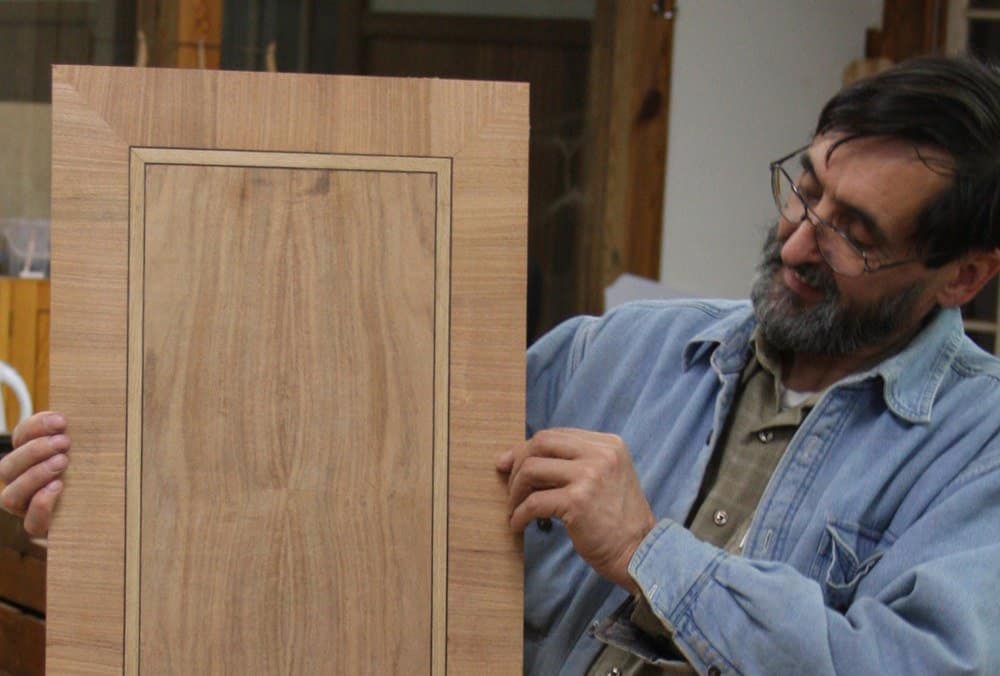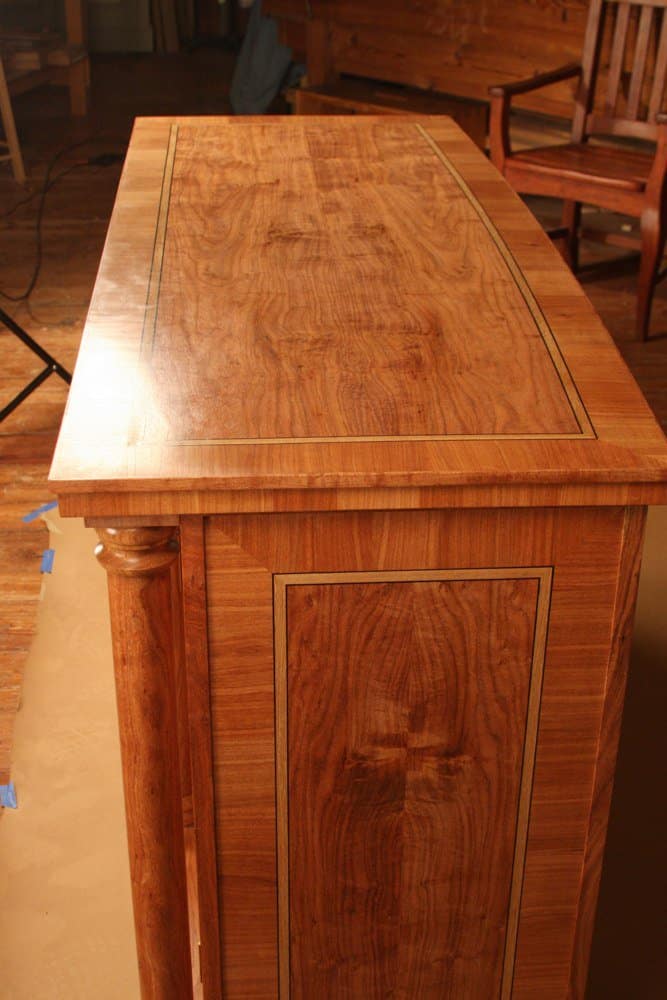A Thought in Design Concepts
Someone asked me to write about my past works and I am reluctant because I have no decent images of what I made nor pictures of me making what I made. I am a dinosaur from the pre-digital era. If I go back too far, say the 1970’s and 80’s , I have almost no photographs, and the ones I have are now stored in Texas in the USA. In the next lines I will describe making a chest of drawers I made and eventually to a man in Houston. I will describe my doubts and my emotions and try to express something you and others might or might not understand. It’s a series. Too long for one post given my always ever-diminishing time.
This piece is a piece I made and sold to a Houston lawyer; for his boardroom centrepiece. It’s not a large piece, quite diminutive for a Texas lawyer, but it had punch and spoke much about Texas wood so few can ever understand because it’s unlikely they will ever see it or know it as I have. I lived in south Texas when I met two men who were cutting mesquite trees and milling it into boards to sell as rough sawn lumber. These two men built my first USA home for me and were both carpenters cum timber saw millers at weekends. I regularly bought mesquite wood from the two men over the first months when I arrived and one day they came to me bright-eyed with a truckload of “something special.”
It would be hard to describe the wood without you thinking I was exaggerating. I don’t know if I could ever find such quality again. As we stood and examined the woodcut it was as if I invaded their excitement, got caught up in it and found myself twirling with them. I think that it was the first time I had seen two adult men, basically cowboys in the true sense of the word, who for the first time in their lives felt the extreme heights of discovery that was no different than those discovering the redwoods of California or the mahoganies of South America. My hands slipped quietly over the poser covered boards and the intense cat-claw figuring popped and popped and popped in 3D reality as I uncovered the grain beneath. Back then I [paid $2 a board foot for mesquite if it was nice and of course ot was always nice. The rough sawn boards were cut to 1 1/8”, 30” wide and sequence cut through and through. The stack was burl or cat-claw for about 40” long and I could see would yield about half of what I saw in useable wood. They invaded my space and sense of discovery with a swift interjection of, “We want $6 a board foot and there’s 120 board feet here.” $720 was hard to come by for me but we cut a deal of half down and half when I sold whatever I made from it or pay up in full if nothing was sold in six months. It worked. I made 10 meat boards and sold them for a $100 each from the non-usable sections because they “Shure looked purdy” to everyone that came by the studio over the next few weeks.
The wood had been dried in a solar kiln Bobby had and then acclimated in the Texas summer sun under tin. Mesquite is the most forgiving wood for drying there is. No other wood comes close. Distinctive features about mesquite is its canary yellow sapwood against the deep reddish purple brown heartwood. Even the sapwood was very highly figured and I was able to work some stunning centre book-matchings using the sap wood as the jewel in the centre. I have done this many times with this and other woods and it looks quite unique and lovely. Here below are some similar panels I used for the White House cabinets to show what I liked in the formation of panels but the woods shown in no way parallel the quality of what I had down in Uvalde and reagan Wells in Texas.
Mesquite panels made with book-matched centre field and skirted with an oak and ebony frieze and an outer band of mesquite crossbanding.
I continued the acclimation process for about a year under my carport where I stored other woods. it’s a mistake to use such wood too soon after purchase. Seasoning is something we have lost and most people call kiln drying seasoning but that’s really not what it is at all.
The White House pieces I designed and then made for the Permanent Collection in 2009
Often I would sit out in the car port and stare at my boards, pull them apart and stare at them. I didn’t want a commission piece to be made from them, I wanted to design a piece for them. I think the process often goes this way for me. processing the thoughts rather than the wood. making the thoughts fit the wood rather than the other way around. it’s something of a luxury to do this but it allows me to step outside of business and consider wood more than perhaps commission work does. All too often commissions have price limits and deadlines. making some pieces without a sale using wood no one else has ever seen allows a privilege to happen that can never be explained. I don’t say all pieces should be that way. Such things are the laughter and the joy that come periodically in life to separate joy from hardship so that contrast separates us from the monotony and the mundane to create spheres of happiness and to explore those unchartered realms of the unknown. Wood like this, and of course other precious woods are jewels where our mind explores passages over weeks and months until we plumb the depths as best this finite mind can and fathom hitherto unreached and untapped depths before we begin to consider how parts begin to fit together in dimensions of unity you felt but never knew existed. This was what happened when Joseph and I made a voice come from wooden parts in a cello we made. Your mind races as never before and your muscles and sinews flex and twist your arms and legs according to each beat your heart takes and makes and trembles for. The chisel, the plane and saw explore as no machine can ever explore. The rhythm starts like a fast pulse starts to pump and you embrace the straining conditions you might never otherwise embrace. And all the time this happens the wood is still; it just lies motionless, stickered in unconsciousness not knowing the plans you developing and forming shapes by every impulse in your sensing mind.





Paul,
Thank you for this blog. What I can see of the piece pictured is stunning.
BillS
Paul,
Great story. Glad I stopped. You have lost your Texas accent though. LOL! But not your Texas heart! You were quite blessed to have a natures wonder to create with. You did it proud!
Paul,
Just wondering, did you use any power tools when making the Whitehouse furniture or the piece for the Texan lawyer? Or did you manage to make these all using hand tools as well?
I usually don’t call machines power tools because its a bit deceptive, certainly a misnomer, but, yes, machines for donkey work and hand tools for creative art. What we accomplished in four weeks was quite impossible but the deadline was two days before President Obamas Inauguration. We had to deliver and ensure the pieces did indeed fit against the curved walls of the Cabinet Room and follow other aspects of the room too. They did of course, I’m a detail person. Most of my personal work in the past was about half and half – proportionally donkey work by machine and the rest hand work. Today handwork is about 95% for some reason. Sanity and control I think.
Dear Paul,
thank you for sharing this great blog post and the beautiful photos.
I cant help but admire the wonderful piece!
Since this post is on design concepts I have a very related question in this domain:
I love the look of the grain direction of the frame on the top of the piece, however, from a wood-movement perspective it is not what you learn in the books, or at school.
How does the top of the piece look from below? And could you use this design for, well, a very representative kitchen table?
Best wishes,
Frank
Aha! More yet to come on this. This panel and the panels you see are veneer panels ready to be vacuum pressed to a sub panel, also of mesquite. Good question!
A few years ago a city official and friend came by my business and asked if I was still doing woodworking on the side. I told him yes, as much as I can why? He had took down 2 giant walnut trees and nobody would take them because of probably having metal in it. I told him that I would take them and thanked him. I ordered a hand held metal detector of ebay and found 23 pieces of bullets, nails,etc. in them. I could find no one to saw them for me locally and had to take them 150 miles to be milled. It turned out to be fantastic grain and color in this wood. It was a magical moment when I finally saw the texture and the combination of sap wood that it had. I have since made most of my daughter’s furniture for her new house. I made a dining room table, sofa tables, hall tables, butcher blocks, and even a pulpit for my church. I have also built items for my friends, at no charge-you see they gave me the trees-so I passed it on to others. I even built a solid walnut mantel for one friend. I have enjoyed your site and your love of being a craftsman and real woodworker, you have taught me so much and I have tried to soak it all up like a sponge. Thank you for what you are doing and for sharing your busy life with others like myself. Thanks and God bless!!!!
Mr Sellers
I have a great respect for you and what you are working to accomplish. I have been working in mesquite since I started in this endeavor. Mine started from economics. As you know mesquite is a weed to ranchers and I’ve never had a problem getting it just for my time. I remember you poo-pooing my surprise at the perfect mesquite in your desk. As you know most woodworkers around here fill voids and imperfections with epoxy or worse… glittery turquois. My surprise at your perfect wood in your desk was based on my experience that out of a given mesquite tree I might yield 40% usable wood.
A friend of mine has a 2000 acre ranch in San Saba. One time he told me to pick any tree on the ranch, I found an old sick mesquite that was severely infested with mistletoe, what stunning burls that tree had, the next season they pushed up the root ball and that yielded even more stunning grain (it sure tore up the chainsaw chain).
One of the things I’ve come to love about mesquite is it’s stability (and it’s perfumy fragrance). I can rough cut mesquite and a year later it is the same shape as when I cut it. We’ve lost some pecan trees from the drought and when I rough cut it, a year later you have to mill a half inch to get it flat again. Sorry to ramble, but once again thank you for what your doing.
DeWayne
There are many woods I love. I think in some ways I love every wood I have ever worked with for different reasons. Mesquite somehow became my first love of all woods. It does have its own personality and of course it has many redeeming qualities, but it’s its richly diverse character that remains the most significant characteristic to me. One day next year I shall be back in Texas for a few weeks all being well. I will find something stunning in a mesquite piece to bring back with me and I have some wood still in storage ready too. Who knows what will be the outcome?
When that one day next year arrives and you are in Texas, if it is less than a weekend drive….it is a big place…..I would surely love to pass by and shake your hand.
Dan
That is stunning. I can’t say it would be my style but I love the crafting of it.
I’m a graphic designer – pretty much everyday I work on a brand. The craft of working out how everything fits together its fun for me, and what’s amazing is how changing different elements of a design can give a completely different feel to a piece.
Paul,
I like your organic design philosophy of using the wood as you see in it what it can be. I will remember you ideas and words as I look at my own wood and see its greatest potential.
Your comment about sitting in your carport looking at your stack of seasoning wood struck a chord (cord? No pun intended). This summer, I cut a fir tree marked for removal down on a neighbor’s lot. I did it with a buck saw, and the tree, 50 feet in length, hit the ground with a satisfying crash. I bucked it into 8 foot lengths, and over time used a rip saw to cut it up in to quarter-sawed lumber. It is definitely not as pretty as the mesquite you describe, but when I go into my shed and see the stack, I can’t help but smile. I would never have done it if I hadn’t seen your workbench videos when you first started posting them on YouTube two or more years ago. A year from now, at Christmas, there will be dovetail boxes and more for the important people in my life. Thank you!
Paul great post as all way’s, as been mentioned I have learned so much from and Thank You for sharing your thoughts and experience. I have a Brother – in – Law who has bought a small Ranch in Texas ( a little south of Dallas ) that he is going to retire there in about 5 years. He is a Pilot and they are Horse people so Texas is a natural for them. He is saving some of that mesquite he has cleared from his land for me, can’t wait to get my hands on it.
By the way such a Beautiful piece for the White House, you must be proud.
Steve
Making the thoughts fit the design is not easy. I’ve screwed up so many times, it’s amazing some of the work you can do. I absolutely love the finish, not too dark not too late, just right. Keep up the great work Mr Sellers.
Wow. Now I want to move to Texas. Gee thanks! Hmm, you should bring some mesquite back from Texas and use it to create that “Making a Bow / Buck Saw” video I’ve been drooling over.